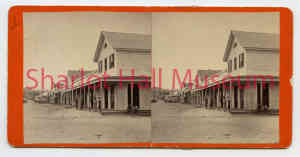By Barbara Patton
The first settlers in the Central Highlands of the Arizona Territory in the 1860’s were seeking gold, as was Albert Noyes, an early pioneer from Maine. He had traveled to California during the Gold Rush, but without a lot of success there, Noyes decided to try Arizona. In 1863 he arrived in Arizona where he and fellow miners established a mining district in the mountains south of present-day Prescott. Other miners asked Noyes and his friends George Lount and E.M. Smith to draw up rules for the Quartz Mountain Mining District. By February 1864, Noyes had claimed his quarter section of land where he intended to mine for gold.
 However, after learning there would be a town built for the territorial capitol, he saw a better financial opportunity harvesting the abundant natural resource provided by the surrounding Ponderosa pine forest. While the first buildings in Prescott were constructed of logs, Albert and George Lount realized settlers would want houses built of milled lumber. So in March 1864, they headed for San Francisco to purchase machinery for Prescott’s first sawmill.
However, after learning there would be a town built for the territorial capitol, he saw a better financial opportunity harvesting the abundant natural resource provided by the surrounding Ponderosa pine forest. While the first buildings in Prescott were constructed of logs, Albert and George Lount realized settlers would want houses built of milled lumber. So in March 1864, they headed for San Francisco to purchase machinery for Prescott’s first sawmill.
After shipping delays and a wagon break down, machinery started arriving in August. Soon the Quartz Mountain Sawmill was set up south of Prescott on the banks of Granite Creek. The business thrived, and in 1867 Noyes and Lount took on a new partner, George Whitfield Curtis, another friend from California. Curtis and Noyes worked together for several years establishing other sawmills as well as quartz mills.
In July 1868, Noyes, then 42, wrote to his sister Olivia in Maine. He told her he was in good health and his business was prosperous, and he expressed how happy he was living in the West. “Certainly the chances of fortune and position are better here and there is no aristocracy. Industry and good behavior are the qualities that make men here.”

Albert also told his sister he would like to get married. Within a couple of years, on Jan 4, 1870, he married Emeline Merriam, a 32-year-old woman originally from Illinois who had been living in California for several years.
One of Noyes’ most remembered achievements was the building of a large saloon and billiard hall on the corner of Montezuma and Gurley streets (present location of St. Michael’s Hotel). The structure was described as the "largest and most magnificent edifice in Prescott, sixty by twenty-eight feet and two stories high.”
Construction began in July of 1868. Unfortunately, on August 14 the building site was flooded by an intense summer monsoon which washed away logs and lumber. Undeterred, Noyes and his crew restarted, and by the end of the month the structure was framed and partly roofed. Townspeople were impressed with the rapid construction. Then on the last day of August, disaster struck again. A powerful wind storm blew the partially completed building to the ground.
Again the resilient construction crew persevered and had the structure back in place within a week. They continued with the finishing work on Prescott’s new pleasure palace and completed it by October. Albert Noyes’ grand achievement was described as “an ornament of the town.” However, he decided not to keep the building and sold it to Andrew Moeller who named the saloon the “Diana.”
 Albert Noyes was a successful businessman, but he was also active in local government. At various times, he was Treasurer of Yavapai County, Coroner, a member of the Territorial Council, Justice of the Peace and Probate Judge.
Albert Noyes was a successful businessman, but he was also active in local government. At various times, he was Treasurer of Yavapai County, Coroner, a member of the Territorial Council, Justice of the Peace and Probate Judge.
On July 1, 1898, A.O. Noyes, 72 years old, passed away at his home south of Prescott. His obituary stated he “was one of our most respected pioneers.”
“Days Past” is a collaborative project of the Sharlot Hall Museum and the Prescott Corral of Westerners International (www.prescottcorral.org). This and other Days Past articles are also available at archives.sharlothallmuseum.org/articles/days-past-articles/1 The public is encouraged to submit proposed articles and inquiries to dayspast@sharlothallmuseum.org Please contact SHM Research Center reference desk at 928-277-2003, or via email at archivesrequest@sharlothallmuseum.org for information or assistance with photo requests.


